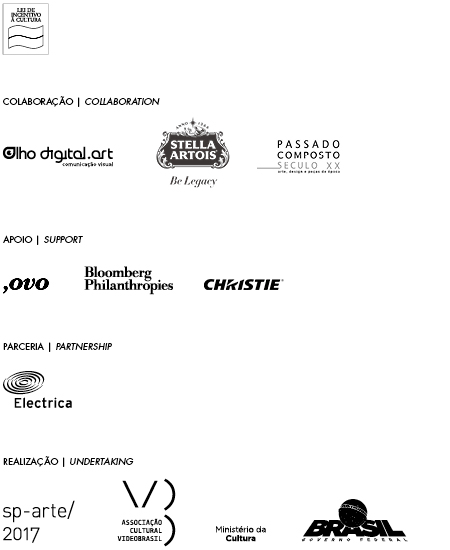Associação Cultural Videobrasil and SP-Arte present Nada levarei quando morrer, aqueles que me devem cobrarei no inferno, the first exhibition of the SP-Arte no Galpão VB project. The show consolidates the partnership initiated in 2015, contributing to the fair’s expansion and placing Galpão VB in the intinerary of its parallel exhibitions, with established names in the arts circuit. Curated by Solange O. Farkas and Gabriel Bogossian, the show features works by Caetano Dias, Claudia Andujar, Miguel Rio Branco, Gisela Motta and Leandro Lima, Rodrigo Bueno, Rodrigo Braga, Runo Lagomarsino, and Virginia de Medeiros.
Nada levarei quando morrer, aqueles que me devem cobrarei no inferno stems from the ideas of the Italian filmmaker Pier Paolo Pasolini, a keen observer of the culture of his time who sought to present, in his films and texts, a critique to the undergoing social transformations in Italy and a record of certain cultural practices which, according to him, were threatened. The Gospel According to St. Matthew (1964), Notes Towards an African Orestes (1970) are examples of a filmography that simultaneously questions the present and pays a sort of tribute to this dissenting cultural repertoire in face of the new rising hegemonic forms against the diversity of the Italian cultures.
The exhibition appropriates this notion, seeking to update it for the Brazilian context. Here, urban populations and indigenous peoples remain threatened either by urban renovation projects that do not consider the need for social inclusion or by developments in infrastructure that make traditional modes of living not viable. In this universe, the works by Caetano Dias, Miguel Rio Branco, and Virgínia de Medeiros, on the one hand, and by Claudia Andujar, Gisela Motta and Leandro Lima, Rodrigo Bueno, Rodrigo Braga, and Runo Lagomarsino, on the other, chronicles the decline of these practices and modes of living from a critical and unconventional perspective.
Whereas Pasolini’s reflection on a disappearing cultural heritage is the exhibition’s point of departure, its title Nada levarei quando morrer, aqueles que me devem cobrarei no inferno—after Miguel Rio Branco’s work featured on the exhibition—brings us closer to an idea of finitude or death. Approached in its broader sense, this notion passes on through the other works assembled here and helps to elicit, together with the experience of trance and sex, a place of resistance for forms of living that endure, insisting on asserting its strength and, especially, its difference.
Solange O. Farkas and Gabriel Bogossian
curators
The Ministry of Culture, Associação Cultural Videobrasil, and SP-Arte present
Nada levarei quando morrer, aqueles que me devem cobrarei no inferno
Caetano Dias, Claudia Andujar, Gisela Motta e Leandro Lima, Miguel Rio Branco, Rodrigo Braga, Rodrigo Bueno, Runo Lagomarsino, Virginia de Medeiros
CURATORS
Solange O. Farkas
Gabriel Bogossian
COORDINATION AND PRODUCTION
Equipe Associação Cultural Videobrasil
PARTICIPATING GALLERIES
Galeria Marília Razuk
Galeria Millan
Galeria Nara Roesler
Galeria Vermelho
Mendes Wood DM
Paulo Darzé Galeria
AUDIOVISUAL INSTALLATION
Paulo Régis
Mike Rocha Santos
Fusion Audio
SCENOGRAPHIC SETUP
Mauro Coelho
Metro Cenografia
PRODUCTION ASSISTANT
Marina Zazá D’Aquino
LIGHTING PROJECT
Anna Turra
LIGHTING EQUIPMENT
Electrica Cinema e Vídeo
WALL PANELS
Olho Digital
TRANSLATION
Márcia Macêdo
PROOFREADING
Paulo Futagawa, Regina Stocklen
PLATFORM:VB
Régis Alves, Ruy Luduvice
WEB DEVELOPMENT
Eduardo Haddad
PRESS OFFICE
Agência Lema
PHOTO RECORDS
Pedro Napolitano Prata
EDUCATIONAL ACTIONS
Luis Filipe Porto
ACKNOWLEDGEMENTS
Alexandre Roesler
André Millan
Cica Lima
Daniel Monteiro
Daniel Roesler
Eduardo Brandão
Eliana Finkelstein
Fernanda Feitosa
Gabriel Zimbardi
Gerson de Oliveira
Leonardo Steil
Marcos Gallon
Marina Goulart
Paulo Darzé
Raissa Paes
Socorro de Andrade Lima
Thais Darzé
Thomaz Farkas Estate

